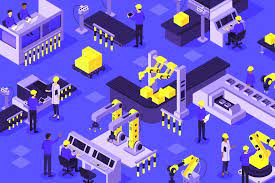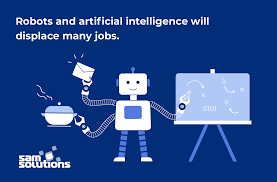The rise of robotics and automation has been transforming industries and workplaces worldwide, leading to significant changes in the job market. While robotics and automation can help to improve efficiency and productivity, they also raise concerns about job displacement and unemployment. In this article, we will explore the impact of robotics on the job market, and consider the potential implications for workers and society as a whole.
Job Displacement and Unemployment
One of the primary concerns about robotics and automation is their potential to displace jobs and lead to unemployment. As robots and automation systems become more advanced, they are increasingly capable of performing tasks that were once done by humans, particularly in manufacturing and other industries. This can lead to job displacement and unemployment, particularly for workers in industries that are heavily reliant on manual labor.
Changes in Skill Requirements
The rise of robotics and automation is also leading to changes in the skill requirements for many jobs. As robots and automation systems become more prevalent, workers will need to develop new skills and competencies in order to remain competitive in the job market. This may require additional training and education, particularly in fields such as engineering, computer science, and data analysis.

New Opportunities and Industries
While robotics and automation can lead to job displacement and changes in skill requirements, they also present new opportunities and industries for workers. As robots and automation systems become more prevalent, new industries and job opportunities are emerging in fields such as robotics engineering, data analysis, and artificial intelligence. This can lead to new and diverse career paths for workers, particularly those with skills and expertise in these areas.
Increased Efficiency and Productivity
One of the primary benefits of robotics and automation is their ability to increase efficiency and productivity in many industries. As robots and automation systems become more prevalent, they can help to reduce costs and increase output, leading to greater efficiency and productivity. This can benefit businesses and organisations, as well as consumers, by providing faster and more efficient services and products.
Impact on Society and the Global Economy
The impact of robotics on the job market has significant implications for society and the global economy. Job displacement and unemployment can lead to social and economic inequality, particularly for workers in industries that are heavily reliant on manual labour. Changes in skill requirements can lead to a skills gap, particularly for workers who may not have access to the training and education they need to remain competitive in the job market. However, the rise of new industries and job opportunities can also lead to new and diverse career paths for workers, particularly those with skills and expertise in robotics and automation.
The impact of robotics on the job market is complex and multifaceted, and will continue to transform many industries and workplaces in the years to come. While robotics and automation can help to improve efficiency and productivity, they also raise concerns about job displacement and unemployment. To respond to these challenges,
It is important to consider the potential implications for workers and society as a whole, and to develop policies and strategies that can help to mitigate the risks and challenges associated with the rise of robotics and automation. By working together to address the impact of robotics on the job market, we can ensure that these technologies are used to benefit society and the global economy, and that their impact is carefully monitored and evaluated.

Additional Tips for Responding to the Impact of Robotics on the Job Market
Invest in Training and Education
To address the changes in skill requirements associated with the rise of robotics and automation, it is important to invest in training and education for workers. This includes providing workers with access to training and education programs that can help them develop the skills and competencies they need to remain competitive in the job market. This may require collaboration between government, educational institutions, and businesses and organisations.
Promote Lifelong Learning
To remain competitive in the job market, workers will need to engage in lifelong learning, particularly in fields related to robotics and automation. This includes staying up-to-date with the latest developments in these fields, and developing new skills and competencies as the job market evolves. Promoting lifelong learning can help to ensure that workers are equipped with the skills and knowledge they need to succeed in the job market, and can help to address the skills gap associated with the rise of robotics and automation.
Develop Policies and Strategies to Support Workers
To mitigate the risks and challenges associated with the rise of robotics and automation, it is important to develop policies and strategies that can support workers who may be affected by job displacement and unemployment. This may include providing financial assistance, retraining programs, and other forms of support to help workers transition to new industries and job opportunities.
Promote Collaboration and Innovation
Collaboration and innovation are also important for responding to the impact of robotics on the job market. This includes fostering collaboration between researchers, developers, and stakeholders, and promoting innovation in the development and use of robotics and automation. By working together to develop and use these technologies in a responsible and ethical manner, we can ensure that they are used to benefit society and the global economy, and that their impact on the job market is carefully monitored and evaluated.
Consider the Broader Social and Economic Implications
The impact of robotics on the job market has broader social and economic implications that extend beyond individual workers and industries. It is important to consider these implications when developing policies and strategies to respond to the impact of robotics on the job market. This may include considering the impact on social and economic inequality, and developing policies and strategies that can help to mitigate these risks.
Conclusion
The impact of robotics on the job market is a complex and multifaceted issue that will require ongoing attention and consideration in the years to come. To respond to the challenges and opportunities associated with the rise of robotics and automation, it is important to invest in training and education, promote lifelong learning, develop policies and strategies to support workers, promote collaboration and innovation, and consider the broader social and economic implications. By working together to address the impact of robotics on the job market, we can ensure that these technologies are used to benefit society and the global economy, and that their impact is carefully monitored and evaluated.
















